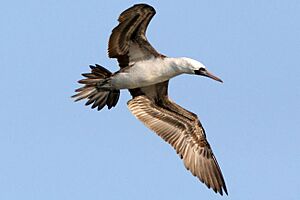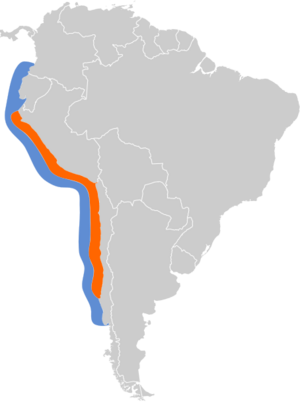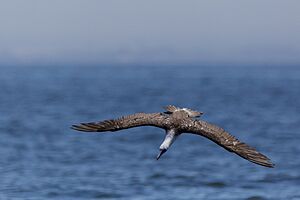Peruvian booby facts for kids
Quick facts for kids Peruvian booby |
|
|---|---|
 |
|
| Conservation status | |
| Scientific classification | |
| Genus: |
Sula
|
| Species: |
variegata
|
 |
|
The Peruvian booby (Sula variegata) is a special bird found only along the Humboldt Current off the coast of Peru. It's a very important hunter in the ocean community. Unlike some of its relatives, it doesn't live in many places. This bird is the most common seabird on the Peruvian coast. It's also the second most important bird for producing guano, which is bird droppings used as fertilizer. In the mid-1900s, there were about 3 million Peruvian boobies!
Contents
What Does the Peruvian Booby Look Like?
The Peruvian booby has brown feathers on its back and the top of its wings. Its belly and head are white. You might notice white spots on the top of its wings, which look a bit like scales. It has a long, pointy, grey bill. Its feet are grey and webbed, which is different from the bright blue feet of the Blue-footed booby or the red feet of the red-footed booby.
Female Peruvian boobies are usually bigger than males. They can be about 19% heavier, and their wings are about 4% larger.
Peruvian Booby Family Tree
The Peruvian booby belongs to a group of birds called Sula. This group includes other well-known boobies like the blue-footed booby, red-footed booby, brown booby, masked booby, and Nazca booby.
There are no different types (subspecies) of Peruvian booby. However, sometimes Peruvian boobies have chicks with blue-footed boobies. This is called hybridization.
Where Do Peruvian Boobies Live?
Peruvian boobies live only in the waters of the Humboldt Current. This current flows along the coast of South America. You can find them off the shores of Peru and south into central Chile. Many studies have been done on these birds on the islands of Lobos de Tierra and Lobos de Afuera because so many boobies live there.
Their colonies build nests on flat, sandy areas that are windy. This helps keep their nests at a good temperature, usually between 28°C and 38°C. These sandy flats, also called pampas, allow many booby nests to be built close together.
Peruvian Booby Behavior
How Peruvian Boobies Talk
Female Peruvian boobies make many different sounds. They can make trumpet-like quacks and honks. Male boobies, on the other hand, tend to whistle. Only adult boobies can make these sounds. It takes a few years for them to learn how to do it.
What Peruvian Boobies Eat
Peruvian boobies mainly eat anchovies, especially a type called Peruvian anchoveta. What they eat can change depending on their age. They also eat mackerel if there are a lot of them around. They rely on the cold, rich waters of the Humboldt Current for a steady supply of food.
Big weather events like El Niño can cause problems for Peruvian boobies. During El Niño, there is less food available for the birds. This means they have fewer successful breeding seasons.
How They Hunt for Food
Peruvian boobies are "plunge divers." This means they dive headfirst into the water to catch fish. Their dives are usually short, lasting about 3 to 3.4 seconds. Sometimes, they can dive for up to 15 seconds. They are relatively shallow divers, usually going between 2.3 and 4.3 meters deep.
They usually hunt close to shore, often less than 5 kilometers from their nests. However, they have been seen as far as 40 kilometers from the coast. Their hunting trips usually last only a few hours. This is much shorter than other seabirds that might spend days hunting at sea. This suggests that Peruvian boobies like to stay close to their colony when they hunt. They hunt in both small and large groups.
They do not hunt in very deep ocean waters. They prefer shallow coastal areas and waters near the edge of the continental shelf. When they are hunting at sea, they spend most of their time (90%) flying. They spend less than 10% of their time actually diving.
How Peruvian Boobies Fly
Peruvian boobies are known as "glide-flappers." This means they flap their wings actively, then glide for short periods. Because of how their wings are shaped and how they fly, they prefer to fly across the wind. This saves energy compared to flying directly into the wind. It also helps them find more prey than flying very fast with the wind.
The average speed of a Peruvian booby is about 44 kilometres per hour (27 mph). However, they have been seen flying as fast as 139 kilometres per hour (86 mph)!
Peruvian Booby Life Cycle
Peruvian boobies can breed all year round. However, their main breeding season is during the spring and summer in the Southern Hemisphere (September to March). If there's enough food, a pair of birds might try to breed a second time in the year.
Peruvian boobies usually lay 2 to 3 eggs, but they can lay anywhere from one to four eggs. The eggs are pale blue. Both parents take turns sitting on the eggs for about 4 to 5 weeks. The chicks stay with their parents for about 3 months. How successful their breeding is depends on how much food is available. It also depends on where the colony is, how big it is, and when they start breeding.
Hybridization with Blue-footed Boobies
Peruvian boobies and blue-footed boobies live in areas that are close but don't quite overlap. Scientists believe they became separate species about 0.25 to 0.45 million years ago. It's not uncommon for these two species to have chicks together. These hybrid female chicks can even lay eggs and raise their own young successfully. This mixing happens most often between female Peruvian boobies and male blue-footed boobies, but the other way around can happen too.
Images for kids
-
A Peruvian booby nest made of guano and soil




